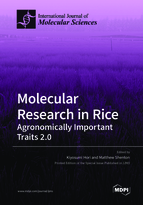Molecular Research in Rice: Agronomically Important Traits 2.0
A special issue of International Journal of Molecular Sciences (ISSN 1422-0067). This special issue belongs to the section "Molecular Plant Sciences".
Deadline for manuscript submissions: closed (30 November 2021) | Viewed by 33322
Special Issue Editors
Interests: plant molecular genetics and breeding; environmental agriculture; rice; QTLs
Special Issues, Collections and Topics in MDPI journals
Interests: plant genomics and genome evolution; genetic resources; rice; association analysis; omics analysis
Special Issues, Collections and Topics in MDPI journals
Special Issue Information
Dear Colleagues,
This Special Issue is the continuation of our Special Issue “Molecular Research in Rice: Agronomically Important Traits” (in which over 20 excellent papers have been published).
Rice (Oryza sativa L.) is the most important food crop in the world, being a staple food for more than half of the world’s population. Recent improvements in living standards have increased the worldwide demand for high-yielding and high-quality rice cultivars. To achieve improved agricultural performance in rice, while overcoming the challenges presented by climate change, it is essential to understand the molecular basis of agronomically important traits and their responses to various environmental conditions. Recently developed techniques in molecular biology, genomics related technologies can reveal the complex molecular mechanisms involved in the control of agronomic traits. As rice was the first crop genome to be sequenced, in 2004, molecular research tools are well-established in rice, and further molecular studies—both now and in the future—will enable the development of novel rice cultivars showing superior agronomic performance.
The purpose of this Special Issue is to explore the molecular basis of agronomically important traits in rice, which is a monocot model crop species. Submissions focusing on a wide range of agronomic traits related to grain yield, grain quality, stress tolerance, and disease resistance are welcome. We will also welcome articles about genetic and environmental interactions of agronomic traits. Studies using natural variation, mutants, and omics analysis such as transcriptomics, epigenetics, and metabolomics, will also be greatly appreciated.
Dr. Kiyosumi Hori
Dr. Matthew Shenton
Guest Editors
Manuscript Submission Information
Manuscripts should be submitted online at www.mdpi.com by registering and logging in to this website. Once you are registered, click here to go to the submission form. Manuscripts can be submitted until the deadline. All submissions that pass pre-check are peer-reviewed. Accepted papers will be published continuously in the journal (as soon as accepted) and will be listed together on the special issue website. Research articles, review articles as well as short communications are invited. For planned papers, a title and short abstract (about 100 words) can be sent to the Editorial Office for announcement on this website.
Submitted manuscripts should not have been published previously, nor be under consideration for publication elsewhere (except conference proceedings papers). All manuscripts are thoroughly refereed through a single-blind peer-review process. A guide for authors and other relevant information for submission of manuscripts is available on the Instructions for Authors page. International Journal of Molecular Sciences is an international peer-reviewed open access semimonthly journal published by MDPI.
Please visit the Instructions for Authors page before submitting a manuscript. There is an Article Processing Charge (APC) for publication in this open access journal. For details about the APC please see here. Submitted papers should be well formatted and use good English. Authors may use MDPI's English editing service prior to publication or during author revisions.
Keywords
- Rice
- Plant molecular biology
- Plant molecular genetics and genomics
- Plant physiology
- Plant pathology
- Omics database
- Genetic and environmental interaction
- Agronomic trait








